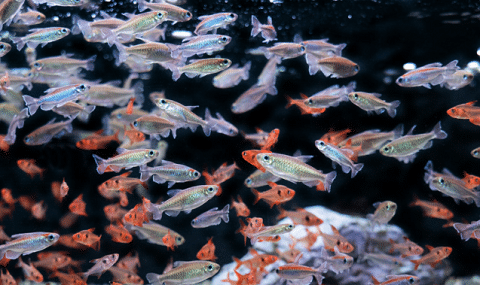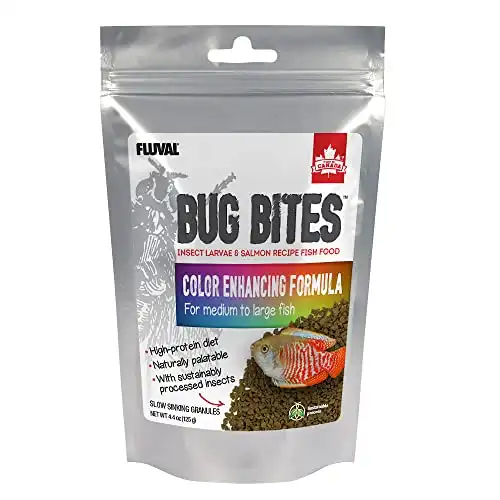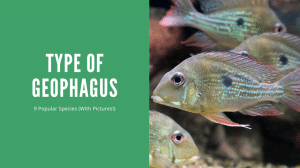Thank you for visiting! By the way… any links on this page that lead to products on Amazon and other stores/partners are affiliate links Aquarium Store Depot earns a commission if you make a purchase.
Every single time when you try to convince yourself to start out as an aquarist, you are always held back by hesitation. You know that there are uncountable fish species in the aquarium line. But, you don’t know which fish will be ideal for a first-time aquarist like you.
Don’t worry, Congo tetra has the capacity to comply with your needs and demands. This freshwater fish knows exactly how to stand out. Their low-maintenance leads you directly to diversify your range of aquarium fish completely trouble-free!
Because they are peaceful and beautiful, aquarists on any awareness stage can house them.
In this guide, we’ll go over their care requirements, history, natural habitat conditions, and pretty much everything you need to know.
Key Takeaways
- Congo Tetras are larger schooling tetras that do great in medium sized tanks
- They are safe around plants
- They live up to 5 years and grow up to 4 inches
Species Overview
| Scientific Name | Phenacogrammus Interruptus |
| Common Names | Cango Tetra |
| Family | Alestidae |
| Origin | Cango River in Zaire, Central Africa |
| Diet | Omnivore |
| Care Level | Easy |
| Activity | Active |
| Lifespan | 3 to 5 years |
| Temperament | Peaceful |
| Tank Level | Middle to top |
| Minimum Tank Size | 20 – 30 gallons |
| Temperature Range | 73° F to 82° F |
| Water Hardness | 3 to 18 KH |
| pH Range | 6.0 to 7.5 |
| Filtration/Water Flow | Moderate to fast |
| Water Type | Freshwater |
| Breeding | Egg layer |
| Difficulty to Breed | Moderate |
| Compatibility | Community tanks |
| OK, for Planted Tanks? | Yes |
What Is A Congo Tetra?
Congo Tetra, scientifically known as Phenacogrammus Interruptus, is a freshwater fish species. They are part of the Alestidae family from the order Characiformes.
Congo tetras are professional representatives of peace, grace, and beauty. With originating from a certain point of the ocean world, they are now an important part of aquariums all around the world.
Apart from these visible characteristics, they are largely capable of morphing themselves according to the need of the hour.
As a beginner or seasoned aquarist, adding Congo Tetras to your tank will be worth the time that you devote to their maintenance.
Origin and Habitat
A Congo Tetra was first sighted in 1949 in the Congo River Basin in Zaire, Africa. They got their name from the Belgian-British zoologist George Albert Boulenger.
Because of being tough to breed, they couldn’t mark their existence in the aquarium world until the 1970s.
For a healthy survival in the wild, Congo Tetras hunt down live insects and prefer living in moderate to fast freshwater currents.
Appearance
A Congo Tetra looks absolutely stunning because of its unique and striking color combination and elegant fins. While fish keepers all around the world admire them due to their calm turn of mind, their colorful bodies help them stand out perfectly, too.

Congo Tetras feature a beautiful spectrum throughout their bodies. While their heads and bellies are covered in blue, a red shade laced with a golden touch dominates the middle part.
Their long and flat bodies look considerably smaller than compared to their beautiful extended fins.
A Congo Tetra composes long fins with subtle transparency visible on their fins. And these fins are yet another reason linked directly to their fame and admiration, with the sporty tail fin serving as a prominent characteristic.
Apart from mixed body coloration, you can see a stripe stretched along their midsections. The band starts from their heads and ends at the tails. Since they have long and translucent fins, Congo Tetras are irresistible to watch while swimming.
There is also a visible shimmer on their bodies. The hue that you see depends on the lighting. Because they have a range of colors, the hue can appear bright mauve, or ocean colored apart from blue.
Even though Congo Tetras are slightly big in comparison with other tetras, they look compressed because of the large midsection.
It is easy to discern males and females. Phenacogrammus Interruptus are sexually dimorphic and therefore have visible gender differences.
As with most fish, the male Congo Tetra fish present vibrant body coloration and colossal size. The females are plumper, especially when they are ready to breed.
Other than being taller and vibrant, the male Conga Tetras have larger dorsal fins. These fins give a feathery appearance that looks more beautiful in the water.
You can also see a violet shade on the fins of males with a beautiful white edging, with their tail fin present along the vertical medial line.
Aside from these beautiful physical characteristics, their dark black and red outlined eyes play an important part in adding up to their beauty even further.
Lifespan
While their average lifespan is between 3 to 5 years, reforming their water conditions can help you support them to live longer and healthier. A Congo Tetra does well with a range of foods, but a well-rounded diet is necessary.
Their ideal water temperature is around 73° to 82° F, with a slightly higher pH level.
Stick around till the end because we will go over all the details, including water conditions and dietary requirements step by step.
Average Size
A Congo Tetra is at least 4 inches long. That’s their average adult fish size, however, they can stretch themselves up to 4.2 inches easily in the wild.
if you have farm-bred Congo Tetras, then growing over 3 or 3.5 inches is pretty hard for them.
As compared to other types of tetras, Phenacogrammus Interruptus are bigger and grow to their full length in a brief span of time.
Care Guide
When it comes to starting out as a beginner aquarist and finding a suitable fish, Congo Tetras fit the bill for many requirements.
There are several reasons they are always on the forefront of mind to consider housing in a freshwater aquarium. One prime example is their easy-to-manage care requirements, easy Congo Tetra diet, and overall demands.
In their natural habitat, the fish is pretty skillful to go with fast water currents and enjoy swimming in low water currents simultaneously. It mainly depends on the situation.
In the wild, they love hunting down live insects to sustain themselves. Unlike other fish that are susceptible to aggressive or territorial behavior, Congo Tetras are completely peaceful and schooling fish.
If you thoroughly understand their water conditions and dietary requirements, they can easily stand firmly against the common fish diseases and live longer.
Here are some essential things to consider before having a Congo Tetra.
Aquarium Setup
While thinking about the Congo Tetra tank setup, being well up on their preferred tank conditions is essential.
In the wild, you can find Congo Tetras in the Congo River, Africa. They live in groups in streams, marshes, pools, and tributaries.
Congo Tetras prefer slightly higher pH levels with large vegetation surrounding them. This calm fish can tolerate subtle water changes, but it’s highly recommended to gauge water parameters as per their needs.
Even though they populate areas where the vegetation is tall, mimicking the exact condition, can disturb their free moving.
Phenacogrammus Interruptus live in the upper sections of water, travelling rarely to the bottom. And as because they are active, you need to secure their tank with a lid to avoid any mishaps.
Tank Size
The ideal Congo tetra tank size should be at least 30 gallons. While some people go under the recommended tank size, I would urge you to get a 30-gallon tank to boost tourism within.
Congo Tetras that are not farm-bred can grow up to 4.2 inches, with the captive-bred at least 3.5 inches long. A schooling fish of this adult fish size will never be happy with smaller tanks.
Even if you overlook their size, think about the decorative items and plants you will introduce to their tanks. Smaller tanks will be filled up with that, leaving little space for the fish. However, a 30-gallon tank can easily house fish and other stuff that you put in it.
Water Parameters
Before housing Phenacogrammus Interruptus, you need to understand what Phenacogrammus Interruptus prefer. Because that has a straight connection with their well-being and is an essential part of proper Congo Tetra care.
The water of the Congo river is slightly acidic, with a water temperature ranging between 73° F to 82° f. Their preferred acidic levels shift between 6.0 to 7.5, with water hardness between 3 to 18 KH.
Filtration and Aeration
As much as other factors involved in their overall maintenance are important, so are filtration and aeration. To keep the ecosystem of their freshwater aquarium intact, you need a solid filtering system.
The excellent recommendations can be a standard canister system or a carbon filtering system. These strong filtration systems will keep the waste levels low and overall water quality up to the mark.
The Pro's Choice
The top choice among professional aquascapers. German engineering and equipped with an intregrated heater.
Lighting
Exposure to bright lighting can significantly disturb their day-to-day activity. Congo Tetras spend most of their time hiding in caves and around plants and neglecting eating and swimming if the lighting is too bright.
Dim light will bring out their proper coloration and motivate them to swim around hassle-free.
Place their freshwater aquarium in a place that is dimly lit. Since monitoring them is important and in subdued light, you can’t do that, use LED bulbs.
Aquatic Plants and Decorations
Your Congo Tetra is a very adaptable fish, but it will not compromise on plants. Plants are not only necessary to make your aquarium beautiful, but they are important to keep oxygen levels up.
While floating aquarium plants will make them feel at home, you are likely to overfill the tank.
To avoid this, try out these live plants:
- Java Fern
- Java Moss
- Water Wisteria
- Water Sprite
- Rotala Indica
- Cabomba
- Anacharis
- Ludwigia repens.
Place these plants at a distance so your fish can easily swim around. Another reason you shouldn’t put the plants closely is the inability to see them due to the density of vegetation.
Your Congo Tetra will use these plants to hide while threatened or when the light is beyond their tolerance. So, make sure you have an adequate amount of them in the tank. Also, introduce caves and aquarium rocks as another hideout option for them.
Tank Maintenance
When the water tank contains so many plants and a group of fish, maintaining it becomes a bit tough.
But, don’t worry! Here are some very easy steps that you can follow to keep your aquarium tank clean and new.
How to clean the tank of Congo Tetras?
- Start with cleaning the aquarium walls with mild soap.
- Weed out the waste plant material and plant new aquarium plants occasionally.
- Use lukewarm water to clean the manufactured caves.
- Add fresh water to the tank every now and again to avoid excessive algae growth.
Substrate
Congo Tetras stay at the middle and top water levels. But a substrate that resembles their natural habitat, River Congo, will be absolutely recommended.
Since Phenacogrammus Interruptus prefer darker water environments, a dark gravel, sand, or silt substrate will be ideal. You don’t have to add too many rocks because the primary focus should always be on fresh plants.
Community Tank Mates
A larger group of aquarists prefer housing Congo Tetras because of their calm nature. As a beginner aquarist, handling any aggressive fish will be really hard. Hence, your chances of having a peaceful fish-keeping journey will be ruined.
A Congo Tetra does well with a range of fish species. They are already schooling fish, which means surviving alone is impossible for them.
But, before I give you a list of tank mates, you should know that the male Congo Tetras are delicate. Any fin-nipper will most probably hunt down their fins, resulting in a serious injury.
Congo Tetra tank mates should align with their size and nature. Here’s a list of some community tank mates to consider:
- Rainbow fish
- Neon Tetras
- Swordtail Fish
- Mollies
- Corydoras
- Ember Tetras
- Barbs
- Elephant Nose Fish
- Dwarf Cichlids
- Rummy Nose Tetras
- Celestial Pearl Danio
- Platy Fish
- Chili Rasbora
Poor Tank Mates
Avoid housing them with any aggressive fish or fin-nipper.
- Bucktooth Tetra
- Tiger Barb
- Flowerhorn Cichlid
- Wolf Cichlid
- Oscar Fish
- Jaguar Cichlid
Breeding Congo Tetras
Breeding Congo Tetras is pretty simple as long as you follow this proper Congo Tetra Guide. It might look complicated to a beginner since no experience gives way to agitation. But it’s easy and interesting.
While many aquarists prefer farm-bred Phenacogrammus Interruptus, you can easily map out all things for proper Congo Tetra breeding in your home aquarium (video source).
To commence the breeding season, get a 20–gallon separate breeding tank for your male Congo Tetra and female Congo Tetra. Place peat moss at the bottom of the tank and keep the temperature up to 77° F. Also, scale down the lighting if you want to prompt them to breed.
Apart from peat moss, you can introduce breeding mops and plants throughout the tank as a safety measure.
While you are working in all these areas, improving water quality is also important. The best way to do this is to introduce peat moss to the breeding tank and wait for at least 3 days. For filtration, I recommend a small air-powered sponge filter to manage the water aeration and flow.
Once you are satisfied with the overall water quality, separate the intended pair from the rest of the group to add to the breeding tank.
But before you allow them to pair off, keep track of their diet for a span of 2 weeks.
Your Congo Tetras will start spawning the next day of getting in a breeding tank. The male will perform a mesmerizing dance around the female before traveling down to the base of the tank together.
The female will then appear swollen with eggs. They can lay almost 500 eggs in a single spawning round, which can be tough to handle. The peat moss will catch the eggs safely where the eggs can lie scattered until they hatch.
Once the female is done laying eggs, separate the pair from the eggs. Because Congo Tetras can eat their own eggs.
Keep the lights subdued because the eggs are super sensitive to strong lighting. The healthy eggs will appear transparent and they require a week to hatch. You can expect them to take another week to become large fry and begin swimming.
Feed the little fry infusoria for a few days, then shift to other foods. To condition them to develop properly, you can start feeding the newly hatched fry baby brine shrimp, lightly crushed flake food, and rotifers.
Pro Tip: To identify infected eggs, look for fungal growth and transparency.
Congo Tetra Food and Diet
Aside from being social and peaceful, they are easy to handle because of their undemanding dietary needs. Congo Tetras are omnivores, which means they sustain themselves on blood worms and insects in the wild.
While insect larvae and blood worms are the base of their diet, eating algae and plant matter is also pretty normal.
You can feed them insect larvae, brine shrimp, flake foods, bloodworms, tubifex, and daphnia in your aquarium. Adding vegetables to their diet will also be good since vegetables are good for providing vitamins. They are quite active fish. So, feed them at intervals to make sure they are fed well. Prepare foods like high-quality fish flake food and pellet food work well as staples. Fluval bug bites are a great option.
Fluval bug bites tropical fish is an excellent staple food for most tropical fish. Made of black solider fly larvae
As a beginner, this is another plus point for you. Because you don’t really have to make any special variations in their diet due to their humble nature.
But while feeding them, make sure the food doesn’t sink to the bottom of the tank. Moreover, feed them food that is small-sized to prompt better digestion and overall health.
Usually, your Congo Tetra will finish its food within 3 minutes. But in case they are exceeding this time frame, pay attention to their daily activities and behavior.
Pro Tip: Nipping at the plant edges is a clear indication that your fish is not getting enough food to stay full. As soon as you notice that, change their timings to ensure they are getting enough food.
Common Health Problems
Congo Tetras are strong fish and do not fall prey to any specific common fish diseases. However, like other fish, they are prone to some common fish ailments caused by unclean water.
In the wild, the water naturally gets clean. But in your aquarium, you need to replicate that condition. This is to ensure that your fish is breathing in a safe aquarium environment free from the waste they produce.
Here are some common diseases with symptoms.
Ich
Ich is a very common fish disease caused by the protozoan Ichthyophthirius multifiliis.
The symptoms are:
- White dots on fins, gills, and other body parts
- Rubbing the body against rough edges
Flukes
This is another common fish disease caused by parasites.
The symptoms are:
- Red spots on the body, especially on the gills
- Difficulty in breathing
- A large amount of mucus
Products like Prazipro are great for treating this disease.
FAQs
How many Congo Tetras can I put in a 30-gallon tank?
A 30-gallon tank is fine for 2-3 Congo Tetras. but if you have other fish in the tank or 5-6 Congo Tetras together, having a 55-gallon tank is highly recommended.
How big do Congo Tetras get?
The average Congo Tetra size is 4.2 inches in the wild. But fish that are farm-bred do not grow this big. They are usually around 3 to 3.5 inches long.
Are Congo Tetras hard to keep?
No. Congo Tetras are hugely popular because of their calm nature and the ability to get along with a range of freshwater fish. Their peaceful disposition allows you to have a safe, happy, and outstanding fish-keeping journey as a beginner.
How many Congo Tetras should be kept together?
Congo Tetras are schooling fish that need tank mates to stay active and healthy. Normally, a group of 6 Congo Tetras is perfect to house together. But for that, you need a bigger tank.
Are Congo Tetras fin nippers?
Congo tetras are not fin nippers. In fact, they are prone to fin-nipping fish because of their delicate fins. Especially with male Phenacogrammus Interruptus, you have to be really careful with who is with them in the tank.
How long does it take for Congo Tetras to mature?
Congo Tetras grow really fast as compared to other fish species. It takes a fry Congo Tetra 3 months to reach 2 inches and almost 6 months to become 3 inches long.
Closing Thoughts
If you’re looking for a beautiful and peaceful fish to add to your community tank or planted aquarium, the Congo Tetra is a great option. These fish are social and thrive when kept in groups, so make sure you have plenty of room in your tank for them! Thanks for reading – we hope you enjoyed this post. Have you kept Congo Tetras before? Let us know your experience in the comments below!
- About the Author
- Latest Posts
I’m thrilled that you found Aquarium Store Depot! Here you’ll find information on fish, aquariums, and all things aquatics related. I’m a hobbyist (being doing this since I was 11) and here to help other hobbyists thrive with their aquariums! I adhere to a high quality Editorial Process and Review products with real life field usage and practical analysis.







